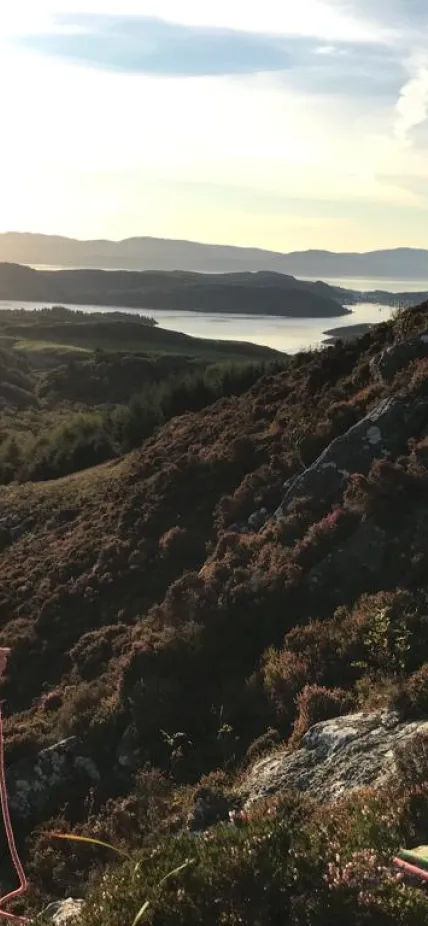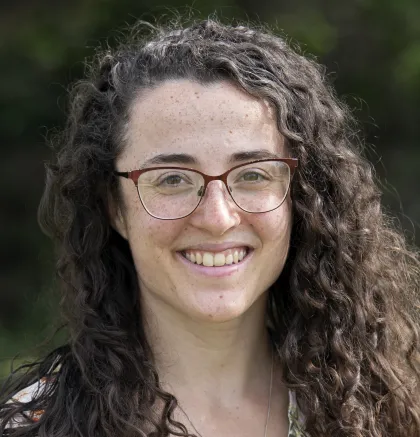
Q: What is your general field of study?
I study molecular plant biology. More specifically, my research focuses on the unique photosynthesis process in green algae. The basic photosynthetic process in land plants and green algae—which live in water—is the same: both absorb and use light from the Sun to convert carbon dioxide and water into chemical energy. Green algae, however, have evolved to adapt to a lack of direct sunlight with a special carbon dioxide (CO2) concentration mechanism that makes them far more efficient at photosynthesis than terrestrial plants. They do this through the generation of a special compartment within the cell called a pyrenoid, which contains a sticky, glue-like protein called RuBisCo that enhances the fixation of CO2. One of my main projects is the development of a new technique that will allow us to visualize this process using microscopy.
Q: What is the coolest thing you’ve worked on so far in your career?
I love the process of examining things up-close using microscopes to solve problems—I find it so fulfilling. Before Carnegie, I did a short postdoc at the University of York, where I researched pyrenoids in green algae. These compartments are covered by a layer of starch, which we think acts as a barrier to gases, preventing the CO2 from leaking out. Using a technology called scanning electron microscopy, we were trying to determine how these barriers form when we discovered a genetic mutant that is not able to properly produce this starch layer at all. These microscopes produce really detailed images of a sample’s surface composition, so I was able to examine with amazing clarity the starch layer from the normally functioning algae and compare it to images of the genetic mutant. It was so beautiful and satisfying to see what was going on inside these cells. Most people have probably seen images from these microscopes without even knowing it. If you’ve seen a really close-up picture of pollen or dust mites, those images were taken using a scanning electron microscope.
There is another really cool kind of microscopy called fluorescent lifetime imaging, which allows us to look at how algae absorb and use light. There is a pigment inside algae called chlorophyll that emits fluorescence and these microscopes allow us to measure the fluorescence and how long it takes the pigment to emit that fluorescence. It has only been a couple of years that we have been using this technique to look at algae’s structure spatially.
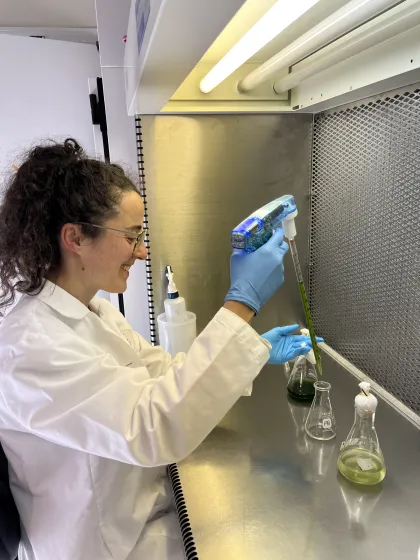
Q: What do you think is the most exciting research direction happening in your field right now?
One of my motivations to explore this particular field of science is that there are so many beneficial, useful applications for humankind and the environment. As I referenced earlier, I study algae’s CO2 concentration mechanism. A massive area of research in my field is trying to determine how we can transfer this mechanism into land plants and crop species, thereby optimizing their photosynthetic capacity. This would have a huge impact on agricultural yields. The focus of my Ph.D. was centered on this research.
Another major development in plant biology research is that we’ve started looking at different types of algae. Since scientists began studying algae’s CO2 concentration mechanism in the 1980s, all of the research focused on one single-celled organism called Chlamydomomas (or “chlamy”, for short). Recently, though, we’ve expanded our research to include a more diverse range of algae. It’s really fascinating because we’re discovering that completely distinct species of algae, which evolved separately, all have a different way of achieving the same CO2 fixation process. It has really broadened our understanding of how this mechanism works and provides added insight as we work toward transferring this process to land plants
Q: Looking 10 years ahead, what future development do you think will have the greatest impact on your field?
I’m currently pivoting the concentration of my studies toward the extraction and use of biofuels from algae. Algae already make oil, and it’s fairly easy to convert that oil into biofuels. However, the process of growing and harvesting oil from algae is difficult and not economically viable at this time. My current project aims to make the production of biofuels from algae’s oil cheaper and much more efficient. Unlocking algae’s potential as a source of renewable energy would provide an alternative to fossil fuels and have a major impact on the environment. To me it just makes so much sense; the prospect of developing an economical model to create automotive and aviation fuel from algae is really exciting.
Q: Do you have a favorite plant and why?
After all this talk about algae, funnily enough my favorite plant is a land plant called a hornwort. They are closely-related to mosses and are the only terrestrial plant that has a pyrenoid, that compartment in algae that is central to the CO2 fixation process. I haven’t seen a hornwort in the wild yet because they are hard to identify. Their most distinctive feature is a little horn—hence their name—but they don’t always have one. I have seen them, though, in botanical gardens. They have a very weird biology; they are a real puzzle and I like following the research about them.

Q: Was your love of science shaped by a particular experience or mentor?
In high school, once we started getting into more detail in my science classes I found myself eager to learn more—beyond what was on the class syllabus. My biology teacher, Dr. Poucher, was very nurturing and encouraged my curiosity. I became interested in bisection and taxidermy, and she let me use some of the school equipment to experiment. Her class definitely ignited my interest in science. Then, as I took additional science classes, my curiosity grew and I wanted to know more and more. I wanted to know everything.
When I went to university at Cambridge, I started to mature as a scientist and learned about doing real research. I had this one lecture, taught by a professor named Mark Carrington, that was essentially a “how-to-do-research” course. Rather than just reviewing various research techniques, he centered the class around a single case study about the discovery of yeast’s life cycle and how yeast cells divide. He took a storytelling approach—almost like a “whodunit” mystery—sharing old papers and walking us, step by step, through the process of solving the puzzle. That lecture was a pivotal turning point for me because prior to that, my plan was to apply to medical school. As soon as the course was over, I asked Mark if I could work in his lab over the summer, which I did. During that experience I had the opportunity to collaborate with a postdoc in the lab called Paula McGregor, who was very supportive; she is someone else who played a key role in my decision to pursue science and research. When I told her I was thinking about switching my degree from medicine to biochemistry with a thesis in research, she’s the one who convinced me to make the switch. She said, “Just do it!” So, I emailed the administration and made it official. Paula studied at the University of Edinburgh, and she was also instrumental in persuading me to do my Ph.D. there.
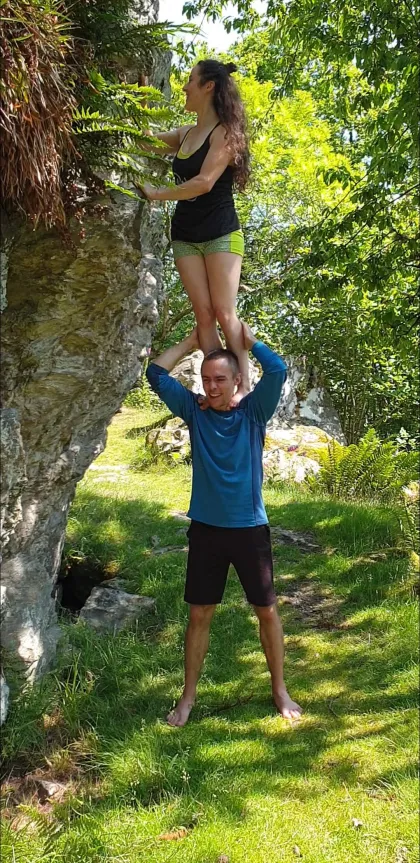
Q: Did you always think you would be a scientist?
Actually, no. When I was younger, I wanted to join the circus. Then, in high school I developed an interest in various fields of science; I went to chemistry camp and took physics. When I went to university, I studied natural sciences—a very broad degree that allowed me to specialize in something different every year. Eventually, I ended up narrowing my focus to photosynthesis, which really captured my interest. During that same time, I joined a community circus group and started performing as a pole dancer on the side. I had already applied for my Ph.D., but loved performing so much. I found myself at an intersection where I was torn between continuing my academic career or becoming a fulltime circus performer. I am actually the first person in my family to become a scientist. Most of them are primary school teachers, including my mom. I used to put on my lab coat and make special appearances in her class to talk about science.
Q: Who is your “Science Superhero?”
I really admire Ursual Goodenough. She’s a retired professor from the University of Washington in St. Louis who did seminal research about eukaryotic algae. She took a lot of the original photos—using scanning electron microscopes—of pyrenoids,algae, and hornworts. When I see an image in a textbook or paper and think, “wow, that’s a really amazing photo,” it’s often she who took the picture. She has also written extensively about striking a balance between being a scientist and having a family, which is really important to me.
Q: What are some of the challenges you have encountered in your career so far and how did you address them?
Historically, my challenge has been tying my self-worth to my identity as a scientist. If my research is going poorly, I feel really sad and bad about myself. On the other hand, if things are going well, I feel great and really passionate and driven. To address that, I try to stay grounded by keeping up with my hobbies. During my Ph.D., I think I went too far into science, and now I make a point of pursuing fun things outside the lab to create more balance. I do a lot of cold-water swimming, for example—I have a goal to swim from Alcatraz Island in San Francisco to the Bay. I also got into life modeling for artists, which is really meditative and good for your body image. And, I’m still involved with the circus. I also think it’s really important to have friends who are not scientists. That helps keep things in perspective. It’s ironic because I have a good friend I know through the circus—he was my acrobatic partner for a while—who, coincidentally, was going through his Ph.D. at Edinburgh at the same time I was doing mine. He decided to quit academia and pursue the circus full time, the exact opposite of what I did. It’s been really interesting seeing our lives diverge; sometimes I even feel a little envious. In general, my philosophy now is to have my eggs in more than one basket. I think that makes you much more resilient and well-rounded.
Q: What advice would you give to graduate students and others who are just starting their scientific careers?
It goes back to developing interests outside of science to ground you, make you more resilient and versatile. Do something you find fun and interesting, because you won’t mind those tough days in the lab quite so much. Developing that balance is so healthy and important. In addition, be thoughtful about who you choose to work with and pick good advisors. Those choices, those people, are central to creating a positive, productive work environment.
Q: Why did you decide to do a postdoctoral position at Carnegie?
One of the reasons I was drawn to Carnegie is that I had read papers by so many different Carnegie scientists that were extraordinary. I had an instinctive feeling that it was the kind of place that would nurture and push me to be the kind of scientist I want to be. One key deciding moment was when I saw a video someone posted on Twitter from a Carnegie summer garden party. It looked like such a fun, friendly environment. In addition to being a highly reputable organization known for great science, it also seemed like a special place—and that has proved to be true.
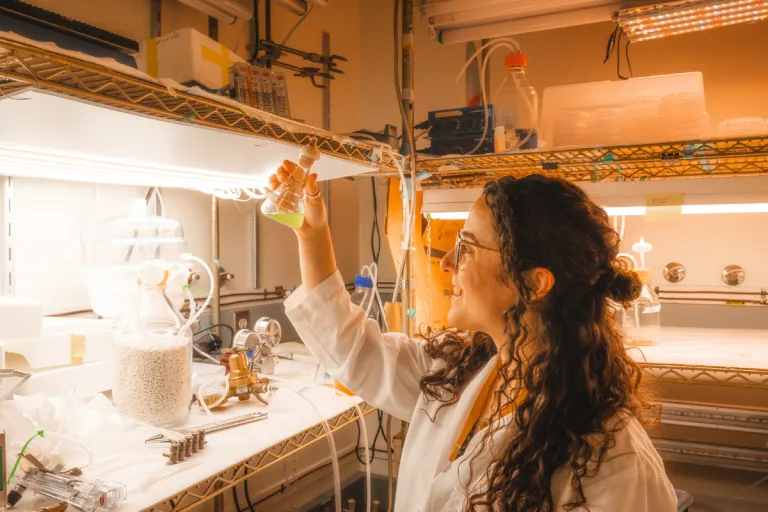
Q: What has your experience at Carnegie meant to you?
I love the sense of community. It’s just this beautiful setting, where people are nice, and supportive, and want good things to happen. I also appreciate how nimble Carnegie is as an organization; things move very quickly if you want to pursue something. I applied for funding for a project, and it came through within two weeks. And recently, I proposed doing a film night, which is more of a social thing, and that was really easy to make happen. It’s a place that is open to change; embraces new ideas; is on the forefront of scientific exploration and discovery. At the same time, it has this uniquely cool legacy and rich history. My experience at Carnegie is definitely fulfilling my expectations. In fact, in many ways it’s even better than I imagined.
